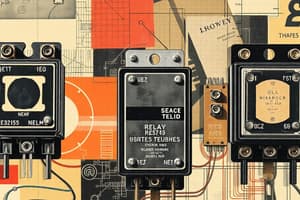Podcast
Questions and Answers
What is the primary function of relays in protection systems?
What is the primary function of relays in protection systems?
- To generate power in a electrical circuit
- To amplify weak signals
- To regulate voltage and current levels
- To detect faults and trip directly (correct)
What type of relay is commonly used as an output relay for many solid-state protective relays?
What type of relay is commonly used as an output relay for many solid-state protective relays?
- Solenoid relay
- Clapper relay
- Telephone relay (correct)
- Induction cup relay
What is the advantage of high-dropout models of solenoid type relays?
What is the advantage of high-dropout models of solenoid type relays?
- They have a lower dropout value (correct)
- They have a higher operating current
- They have a higher pickup value
- They have multiple contacts
What is the purpose of taps or other means in AC type relays?
What is the purpose of taps or other means in AC type relays?
What happens when the current or voltage drops to the order of 60% of the pickup value in some relays?
What happens when the current or voltage drops to the order of 60% of the pickup value in some relays?
What type of relay is used as a seal-in contact switch in DC applications?
What type of relay is used as a seal-in contact switch in DC applications?
What is the percentage of the pickup value at which the fault detectors will reset?
What is the percentage of the pickup value at which the fault detectors will reset?
What is the primary function of the moving cup or cylinder in the AC induction cup or induction cylinder unit?
What is the primary function of the moving cup or cylinder in the AC induction cup or induction cylinder unit?
What type of fault detectors are recommended in general?
What type of fault detectors are recommended in general?
What happens when the fluxes of coils one and two are in phase?
What happens when the fluxes of coils one and two are in phase?
What is the typical time of operation of the instantaneous overcurrent unit?
What is the typical time of operation of the instantaneous overcurrent unit?
Flashcards are hidden until you start studying




